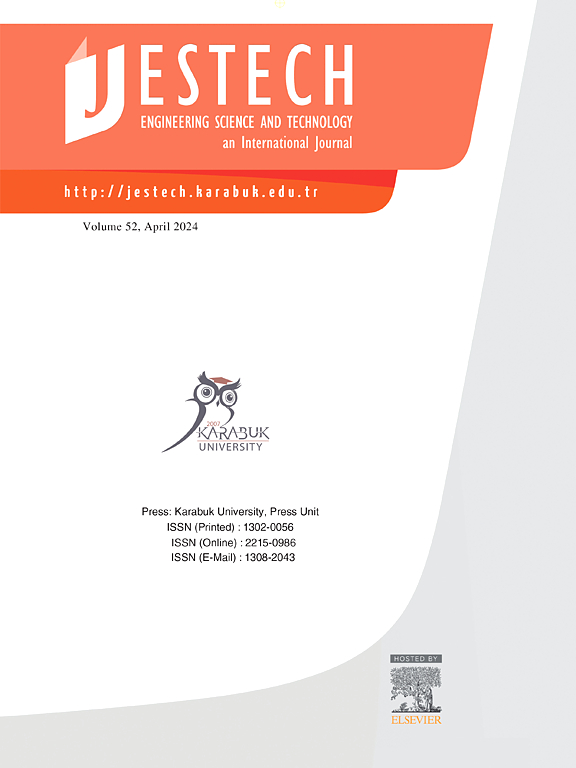对承受循环荷载的复合剪力墙行为的实验验证数值研究
IF 5.4
2区 工程技术
Q1 ENGINEERING, MULTIDISCIPLINARY
Engineering Science and Technology-An International Journal-Jestech
Pub Date : 2024-11-01
DOI:10.1016/j.jestch.2024.101884
引用次数: 0
摘要
出于设计考虑,钢筋混凝土(RC)剪力墙的截面较窄,含有过多的钢筋,通常用于高层建筑的抗震,以产生功能性平面图。然而,在钢筋混凝土剪力墙的端部区域构件中尤为明显的是,粗大的钢筋会导致混凝土浇筑困难并造成混凝土离析。因此,本研究集中对使用冷弯钢板(CFSS)构件制作的复合剪力墙在循环荷载下的行为进行数值研究。使用 ABAQUS 有限元分析软件对剪力墙端部区域使用 L 型 CFSS 的三个复合剪力墙试件进行了 1/3 比例建模。数值分析研究了试样在每个加载阶段的裂纹扩展行为,并通过实验进行了验证。此外,还利用侧向力-顶位移关系评估了墙体的行为。结果表明,建模方法准确地模拟了复合剪力墙的行为。最后,在验证数值模拟的基础上进行了参数分析,以研究 CFSS 元素的材料特性对复合剪力墙的影响。参数研究表明,钢板的屈服强度和与中轴线的位置会影响剪力墙的侧向承载能力。本文章由计算机程序翻译,如有差异,请以英文原文为准。
Experimentally validated numerical investigation on the behavior of composite shear walls subjected to cyclic loading
Due to design considerations, reinforced concrete (RC) shear walls, with narrow cross-sections containing excessive steel reinforcing bars, are commonly used in tall buildings for seismic resistance to produce functional floor plans. However, as is particularly evident in the end region components of the RC shear walls, bulky reinforcement can lead to difficulties in concrete pouring and cause concrete segregation. Accordingly, this study concentrates on the numerical investigation of composite shear wall behavior created using cold-formed steel sheet (CFSS) elements under cyclic loading. Three composite shear wall test specimens, having L-shaped CFSSs utilized in the shear wall end regions, were modeled on a 1/3 scale with ABAQUS finite element analysis software. The specimens’ crack propagation behavior was investigated at each loading stage in the numerical analyses and validated with experiments. Furthermore, the lateral force-top displacement relationship was used to assess the wall’s behaviors. According to the results, the modeling approach accurately simulates the composite shear wall’s behavior. Finally, a parametric analysis was performed with the verified numerical simulations to examine the effect of the CFSS elements’ material properties on the composite shear walls. The parametric studies revealed that the steel sheets’ yield strength and position from the neutral axis affected the shear walls’ lateral load-bearing capacity.
求助全文
通过发布文献求助,成功后即可免费获取论文全文。
去求助
来源期刊

Engineering Science and Technology-An International Journal-Jestech
Materials Science-Electronic, Optical and Magnetic Materials
CiteScore
11.20
自引率
3.50%
发文量
153
审稿时长
22 days
期刊介绍:
Engineering Science and Technology, an International Journal (JESTECH) (formerly Technology), a peer-reviewed quarterly engineering journal, publishes both theoretical and experimental high quality papers of permanent interest, not previously published in journals, in the field of engineering and applied science which aims to promote the theory and practice of technology and engineering. In addition to peer-reviewed original research papers, the Editorial Board welcomes original research reports, state-of-the-art reviews and communications in the broadly defined field of engineering science and technology.
The scope of JESTECH includes a wide spectrum of subjects including:
-Electrical/Electronics and Computer Engineering (Biomedical Engineering and Instrumentation; Coding, Cryptography, and Information Protection; Communications, Networks, Mobile Computing and Distributed Systems; Compilers and Operating Systems; Computer Architecture, Parallel Processing, and Dependability; Computer Vision and Robotics; Control Theory; Electromagnetic Waves, Microwave Techniques and Antennas; Embedded Systems; Integrated Circuits, VLSI Design, Testing, and CAD; Microelectromechanical Systems; Microelectronics, and Electronic Devices and Circuits; Power, Energy and Energy Conversion Systems; Signal, Image, and Speech Processing)
-Mechanical and Civil Engineering (Automotive Technologies; Biomechanics; Construction Materials; Design and Manufacturing; Dynamics and Control; Energy Generation, Utilization, Conversion, and Storage; Fluid Mechanics and Hydraulics; Heat and Mass Transfer; Micro-Nano Sciences; Renewable and Sustainable Energy Technologies; Robotics and Mechatronics; Solid Mechanics and Structure; Thermal Sciences)
-Metallurgical and Materials Engineering (Advanced Materials Science; Biomaterials; Ceramic and Inorgnanic Materials; Electronic-Magnetic Materials; Energy and Environment; Materials Characterizastion; Metallurgy; Polymers and Nanocomposites)
 求助内容:
求助内容: 应助结果提醒方式:
应助结果提醒方式:


